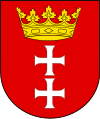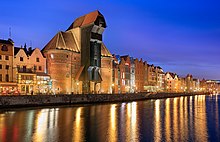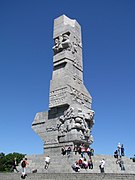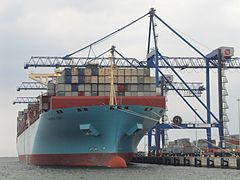Gdańsk
Gdańsk | |
|---|---|
      
| |
 Flag | |
| Motto(s): Nec Temere, Nec Timide (Neither rashly, nor timidly) | |
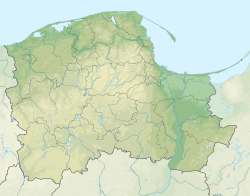 Gdańsk Location of Gdańsk in Poland | |
| Coordinates: 54°22′N 18°38′E / 54.367°N 18.633°ECoordinates: 54°22′N 18°38′E / 54.367°N 18.633°E | |
| Country | |
| Voivodeship | |
| County | city county |
| Established | 10th century |
| City rights | 1263 |
| Government | |
| • Mayor | Aleksandra Dulkiewicz (PO) |
| Area | |
| • City | 262 km2 (101 sq mi) |
| Highest elevation | 180 m (590 ft) |
| Population (31 December 2019) | |
| • City | 470,907 |
| • Density | 1,800/km2 (5,000/sq mi) |
| • Metro | 1,080,700 |
| Time zone | UTC+1 (CET) |
| • Summer (DST) | UTC+2 (CEST) |
| Postal code | 80-008 to 80–958 |
| Area code(s) | +48 58 |
| Car plates | GD |
| Website | gdansk.pl |
Gdańsk (/ɡəˈdænsk/ gə-DANSK, also US: /ɡəˈdɑːnsk/ gə-DAHNSK;[2] Polish: [ɡdaɲsk] (![]() listen); German: Danzig [ˈdantsɪç] (
listen); German: Danzig [ˈdantsɪç] (![]() listen); Kashubian: Gduńsk) is a city on the Baltic coast of northern Poland. With a population of 470,907,[1] Gdańsk is the capital and largest city of the Pomeranian Voivodeship and the most prominent city in the geographical region of Pomerania. It is Poland's principal seaport and the country's fourth-largest metropolitan area.[3]
listen); Kashubian: Gduńsk) is a city on the Baltic coast of northern Poland. With a population of 470,907,[1] Gdańsk is the capital and largest city of the Pomeranian Voivodeship and the most prominent city in the geographical region of Pomerania. It is Poland's principal seaport and the country's fourth-largest metropolitan area.[3]
The city is at the southern edge of Gdańsk Bay, on the Baltic Sea, in a conurbation with the city of Gdynia, the resort town of Sopot, and suburban communities; these form a metropolitan area called the Tricity (Trójmiasto), with a population of approximately 1.5 million.[4] Gdańsk lies at the mouth of the Motława River, connected to the Leniwka, a branch in the delta of the nearby Vistula River, which drains 60 percent of Poland and connects Gdańsk with the Polish capital, Warsaw. Together with the nearby port of Gdynia, Gdańsk is also an industrial centre.
The city's history is complex, with periods of Polish, Prussian and German rule, and periods of autonomy or self-rule as a free city state. In the early-modern age, Gdańsk was a royal city of Poland. It was considered the wealthiest and the largest city of Poland, before the 18th century rapid growth of Warsaw. In the late Middle Ages it was an important seaport and shipbuilding town and, in the 14th and 15th centuries, a member of the Hanseatic League.
In the interwar period, Gdańsk lay in a disputed region between Poland and Germany, which became known as the Polish Corridor. The city's ambiguous political status was exploited by Germany, furthering tension between the two countries, which would ultimately culminate in the Invasion of Poland and the first clash of the Second World War just outside the city, followed by the ethnic cleansing and executions of Polish-speaking minority population and ultimately flight and expulsion of the German-speaking majority of the city's population in 1945.
In the 1980s, Gdańsk was the birthplace of the Solidarity movement, which played a major role in bringing an end to communist rule in Poland and helped precipitate the collapse of the Eastern Bloc, the fall of the Berlin Wall and the dissolution of the Warsaw Pact.
Gdańsk is home to the University of Gdańsk, Gdańsk University of Technology, the National Museum, the Gdańsk Shakespeare Theatre, the Museum of the Second World War, the Polish Baltic Philharmonic and the European Solidarity Centre. The city also hosts St. Dominic's Fair, which dates back to 1260,[5] and is regarded as one of the biggest trade and cultural events in Europe.[6] Gdańsk has also topped rankings for the quality of life, safety and living standards worldwide.[7][8][9]
Names[]

The city's name is thought to originate from the Gdania River,[10] the original name of the Motława branch on which the city is situated. The name of a settlement was recorded after St. Adalbert's death in AD 997 as urbs Gyddanyzc[11] and it was later written as Kdanzk in 1148, Gdanzc in 1188, Danceke[12] in 1228, Gdańsk in 1236,[13] Danzc in 1263, Danczk in 1311,[14] Danczik in 1399,[11][15] Danczig in 1414, Gdąnsk in 1656. In Polish the modern name of the city is pronounced [ɡdaj̃sk] (![]() listen). In English (where the diacritic over the "n" is frequently omitted) the usual pronunciation is /ɡəˈdænsk/ or /ɡəˈdɑːnsk/. The German name, Danzig, is pronounced [ˈdantsɪç] (
listen). In English (where the diacritic over the "n" is frequently omitted) the usual pronunciation is /ɡəˈdænsk/ or /ɡəˈdɑːnsk/. The German name, Danzig, is pronounced [ˈdantsɪç] (![]() listen).
listen).
The city's Latin name may be given as either Gedania, Gedanum or Dantiscum; the variety of Latin names reflects the mixed influence of the city's Polish, German and Kashubian heritage. Other former spellings of the name include Dantzig, Dantsic and Dantzic.
Ceremonial names[]
On special occasions the city is also referred to as "The Royal Polish City of Gdańsk" (Polish Królewskie Polskie Miasto Gdańsk, Latin Regia Civitas Polonica Gedanensis, Kashubian Królewsczi Polsczi Gard Gduńsk).[16][17][18] In the Kashubian language the city is called Gduńsk. Although some Kashubians may also use the name "Our Capital City Gduńsk" (Nasz Stoleczny Gard Gduńsk) or "The Kashubian Capital City Gduńsk" (Stoleczny Kaszëbsczi Gard Gduńsk), the cultural and historical connections between the city and the region of Kashubia are debatable and use of such names rises controversy among Kashubians.
History[]
Early Poland[]
The first written record thought to refer to Gdańsk is the vita of Saint Adalbert. Written in 999, it describes how in 997 Saint Adalbert of Prague baptised the inhabitants of urbs Gyddannyzc, "which separated the great realm of the duke [i.e. Boleslaw the Brave of Poland] from the sea."[20] No further written sources exist for the 10th and 11th centuries.[20] Based on the date in Adalbert's vita, the city celebrated its millennial anniversary in 1997.[21]
Archaeological evidence for the origins of the town was retrieved mostly after World War II had laid 90 percent of the city centre in ruins, enabling excavations.[22] The oldest seventeen settlement levels were dated to between 980 and 1308.[21] It is generally thought that Mieszko I of Poland erected a stronghold on the site in the 980s, thereby connecting the Polish state ruled by the Piast dynasty with the trade routes of the Baltic Sea.[23] Traces of buildings and housing from the 10th century have been found in archaeological excavations of the city.[24]
Pomeranian Poland[]

The site was ruled as a duchy of Poland by the Samborides. It consisted of a settlement at the modern Long Market, settlements of craftsmen along the Old Ditch, German merchant settlements around St Nicholas's church and the old Piast stronghold.[25] In 1186, a Cistercian monastery was set up in nearby Oliwa, which is now within the city limits. In 1215, the ducal stronghold became the centre of a Pomerelian splinter duchy. At that time the area of the later city included various villages. From at least 1224/25 a German market settlement with merchants from Lübeck existed in the area of today's Long Market.[26]
In 1224/25, merchants from Lübeck were invited as hospites (immigrants with specific privileges) but were soon (in 1238) forced to leave by Swantopolk II of the Samborides during a war between Swantopolk and the Teutonic Knights, during which Lübeck supported the latter. Migration of merchants to the town resumed in 1257.[27] Significant German influence did not reappear until the 14th century, after the takeover of the city by the Teutonic Knights.[28]
At latest in 1263 Pomerelian duke, Swantopolk II. granted city rights under Lübeck law to the emerging market settlement.[26] It was an autonomy charter similar to that of Lübeck, which was also the primary origin of many settlers.[25] In a document of 1271 the Pomerelian duke Mestwin II addressed the Lübeck merchants settled in the city as his loyal citizens from Germany.[29][30]
In 1300, the town had an estimated population of 2,000.[31] While overall the town was far from an important trade centre at that time, it had some relevance in the trade with Eastern Europe.[31] Low on funds, the Samborides lent the settlement to Brandenburg, although they planned to take the city back and give it to Poland. Poland threatened to intervene, and the Brandenburgians left the town. Subsequently, the city was taken by Danish princes in 1301. The Teutonic Knights were hired by the Polish nobles to drive out the Danes.
Teutonic Knights[]

In 1308, the town was taken by Brandenburg and the Teutonic Knights restored order. Subsequently, the Knights took over control of the town. Primary sources record a massacre carried out by the Teutonic Knights against the local population,[32] of 10,000 people, but the exact number killed is subject of dispute in modern scholarship.[33] Some authors accept the number given in the original sources,[34] while others consider 10,000 to have been a medieval exaggeration, although scholarly consensus is that a massacre of some magnitude did take place.[33] The events were used by the Polish crown to condemn the Teutonic Knights in a subsequent papal lawsuit.[33][35]
The knights colonised the area, replacing local Kashubians and Poles with German settlers.[34] In 1308, they founded Osiek Hakelwerk near the town, initially as a Slavic fishing settlement.[32] In 1340, the Teutonic Knights constructed a large fortress, which became the seat of the knights' Komtur.[36] In 1346 they changed the Town Law of the city, which then consisted only of the Rechtstadt, to Kulm law.[37] In 1358, Danzig joined the Hanseatic League, and became an active member in 1361.[38] It maintained relations with the trade centres Bruges, Novgorod, Lisboa and Sevilla.[38] Around 1377, the Old Town was equipped with city rights as well.[39] In 1380, the New Town was founded as the third, independent settlement.[32]
After a series of Polish-Teutonic Wars, in the Treaty of Kalisz (1343) the Order had to acknowledge that it would hold Pomerelia as a fief from the Polish Crown. Although it left the legal basis of the Order's possession of the province in some doubt, the city thrived as a result of increased exports of grain (especially wheat), timber, potash, tar, and other goods of forestry from Prussia and Poland via the Vistula River trading routes, although after its capture, the Teutonic Knights tried to actively reduce the economic significance of the town. While under the control of the Teutonic Order German migration increased. The Order's religious networks helped to develop Danzig's literary culture.[40] A new war broke out in 1409, culminating in the Battle of Grunwald (1410), and the city came under the control of the Kingdom of Poland. A year later, with the First Peace of Thorn, it returned to the Teutonic Order.[41]
Kingdom of Poland[]

In 1440, the city participated in the foundation of the Prussian Confederation which was an organisation opposed to the rule of the Teutonic Knights. The organisation in its complaint of 1453 mentioned repeated cases in which the Teutonic Knights imprisoned or murdered local patricians and mayors without a court verdict.[42] Upon the request of the organisation King Casimir IV of Poland reincorporated the territory to the Kingdom of Poland in 1454.[43] This led to the Thirteen Years' War between Poland and the State of the Teutonic Order (1454–1466). Since 1454, the city was authorized by the King to mint Polish coins.[44] The local mayor pledged allegiance to the King during the incorporation in March 1454 in Kraków,[45] and the city again solemnly pledged allegiance to the King in June 1454 in Elbląg, recognizing the prior Teutonic annexation and rule as unlawful.[46] On 25 May 1457 the city gained its rights as an autonomous city.[47]
On 15 May 1457, Casimir IV of Poland granted the town the Great Privilege, after he had been invited by the town's council and had already stayed in town for five weeks.[48] With the Great Privilege, the town was granted full autonomy and protection by the King of Poland.[49] The privilege removed tariffs and taxes on trade within Poland, Lithuania and Ruthenia (present day Belarus and Ukraine) and conferred on the town independent jurisdiction, legislation and administration of her territory, as well as the right to mint its own coin.[48] Furthermore, the privilege united Old Town, Osiek and Main Town, and legalised the demolition of New Town, which had sided with the Teutonic Knights.[48] By 1457, New Town was demolished completely, no buildings remained.[32]
Gaining free and privileged access to Polish markets, the seaport prospered while simultaneously trading with the other Hanseatic cities. After the Second Peace of Thorn (1466) between Poland and the Teutonic Order the warfare ended permanently. After the Union of Lublin between Poland and Lithuania in 1569 the city continued to enjoy a large degree of internal autonomy (cf. Danzig law). Being the largest and one of the most influential cities of Poland, it enjoyed voting rights during the royal election period in Poland.

In 1569 a Mennonite Church was founded here.
In the 1575 election of a king to the Polish throne, Danzig supported Maximilian II in his struggle against Stephen Báthory. It was the latter who eventually became monarch but the city, encouraged by the secret support of Denmark and Emperor Maximilian, shut its gates against Stephen. After the Siege of Danzig (1577), lasting six months, the city's army of 5,000 mercenaries was utterly defeated in a field battle on 16 December 1577. However, since Stephen's armies were unable to take the city by force, a compromise was reached: Stephen Báthory confirmed the city's special status and her Danzig law privileges granted by earlier Polish kings. The city recognised him as ruler of Poland and paid the enormous sum of 200,000 guldens in gold as payoff ("apology").
Around 1640, Johannes Hevelius established his astronomical observatory in the Old Town. Polish King John III Sobieski regularly visited Hevelius numerous times.
Beside a majority of German-speakers,[52] whose elites sometimes distinguished their German dialect as Pomerelian,[53] the city was home to a large number of Polish-speaking Poles, Jewish Poles, Latvian speaking Kursenieki, Flemings and Dutch. In addition, a number of Scots took refuge or migrated to and received citizenship in the city. During the Protestant Reformation, most German-speaking inhabitants adopted Lutheranism. Due to the special status of the city and significance within the Polish–Lithuanian Commonwealth, the city inhabitants largely became bi-cultural sharing both Polish and German culture and were strongly attached to the traditions of the Polish–Lithuanian Commonwealth.[54]
The city suffered a last great plague and a slow economic decline due to the wars of the 18th century. As a stronghold of Stanisław Leszczyński's supporters during the War of the Polish Succession, it was taken by the Russians after the Siege of Danzig in 1734.

The Danzig Research Society (in German Naturforschende Gesellschaft in Danzig) founded in 1743 was one of the first of its kind.
Prussia and Germany[]
Danzig was annexed by the Kingdom of Prussia in 1793,[55] in the Second Partition of Poland. Both the Polish and the German-speaking population largely opposed the Prussian annexation and wished the city to remain part of Poland.[56] The mayor of the city stepped down from his office due to the annexation,[57] and also notable city councilor Jan (Johann) Uphagen, historian and art collector, whose Baroque house is now a museum, resigned as a sign of protest against the annexation.[58] An attempted student uprising against Prussia led by was crushed quickly by the authorities in 1797.[59][60][61]
During the Napoleonic era the city became a free city from 1807 to 1814.
In 1815, after France's defeat in the Napoleonic Wars, it again became part of Prussia[55] and became the capital of Regierungsbezirk Danzig within the province of West Prussia. The city's longest serving president was Robert von Blumenthal, who held office from 1841, through the revolutions of 1848, until 1863. With the unification of Germany in 1871 under Prussian hegemony, the city became part of the German Empire and remained so until 1919, after Germany's defeat in World War I.
Inter-war years and World War II[]

When Poland regained its independence after World War I with access to the sea as promised by the Allies on the basis of Woodrow Wilson's "Fourteen Points" (point 13 called for "an independent Polish state", "which should be assured a free and secure access to the sea"), the Poles hoped the city's harbour would also become part of Poland.
However, in the end – since Germans formed a majority in the city, with Poles being a minority (in the 1923 census 7,896 people out of 335,921 gave Polish, Kashubian or Masurian as their native language)[62] – the city was not placed under Polish sovereignty. Instead, in accordance with the terms of the Versailles Treaty, it became the Free City of Danzig (German: Freie Stadt Danzig), an independent quasi-state under the auspices of the League of Nations with its external affairs largely under Polish control – without, however, any public vote to legitimize Germany's loss of the city.[63]
Poland's rights also included free use of the harbour, a Polish post office, a Polish garrison in Westerplatte district, and customs union with Poland. This arrangement was inspired by the history of the city, which for hundreds of years was part of Poland, with which it shared economic interests, thanks to which it flourished, and within which it enjoyed wide autonomy.[63] This led to a considerable tension between the local German administration and the Republic of Poland. The Free City had its own constitution, national anthem, parliament, and government (Senat). It issued its own stamps as well as its currency, the Danzig gulden.
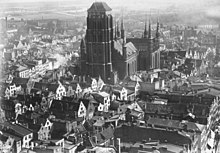
With the growth of Nazism among Germans, Anti-Polish sentiment increased and both Germanisation and segregation policies intensified, in the 1930s the rights of local Poles were commonly violated and limited by the local administration.[64] Polish children were refused admission to public Polish-language schools, premises were not allowed to be rented to Polish schools and preschools.[65] Due to such policies, only 8 Polish-language public schools existed in the city, and Poles managed to organize 7 more private Polish schools.[65]
In 1937, Poles who sent their children to private Polish schools were demanded to transfer children to German schools, under threat of police intervention, and attacks were carried out on Polish schools and Polish youth.[65] German militias carried out numerous beatings of Polish activists, scouts and even mailmen, as "punishment" for distributing the Polish press.[66] German students attacked and expelled Polish students from the technical university.[66] Dozens of Polish surnames were forcibly Germanized,[66] while Polish symbols that reminded that for centuries Gdańsk was part of Poland were removed from the city's landmarks, such as the Artus Court and the Neptune's Fountain.[67]
From 1937, the employment of Poles by German companies was prohibited, and already employed Poles were fired, the use of Polish in public places was banned and Poles were not allowed to enter several restaurants, in particular those owned by Germans.[67] In 1939, before the German invasion of Poland and outbreak of World War II, local Polish railwaymen were victims of beatings, and after the invasion, they were also imprisoned and murdered in Nazi concentration camps.[68]
In the early 1930s, the local Nazi Party capitalised on pro-German sentiments and in 1933 garnered 50% of vote in the parliament. Thereafter, the Nazis under Gauleiter Albert Forster achieved dominance in the city government, which was still nominally overseen by the League of Nations' High Commissioner. The German government officially demanded the return of Danzig to Germany along with an extraterritorial (meaning under German jurisdiction) highway through the area of the Polish Corridor for land-based access from the rest of Germany. Hitler used the issue of the status of the city as a pretext for attacking Poland and in May 1939, during a high-level meeting of German military officials explained to them: "It is not Danzig that is at stake. For us it is a matter of expanding our Lebensraum in the east", adding that there will be no repeat of the Czech situation, and Germany will attack Poland at first opportunity, after isolating the country from its Western Allies.[69][70][71][72][73]
After the German proposals to solve the three main issues peacefully were refused, German-Polish relations rapidly deteriorated. Germany attacked Poland on 1 September after having signed a non-aggression pact with the Soviet Union (which included a Secret Part regarding the division of Poland and the Baltic States between the two countries) in late August and after postponing the attack three times.

The German attack began in Danzig, with a bombardment of Polish positions at Westerplatte by the German battleship Schleswig-Holstein, and the landing of German infantry on the peninsula. Outnumbered Polish defenders at Westerplatte resisted for seven days before running out of ammunition. Meanwhile, after a fierce day-long fight (1 September 1939), defenders of the Polish Post office were tried and executed then buried on the spot in the Danzig quarter of Zaspa in October 1939. In 1998 a German court overturned their conviction and sentence.

The city was officially annexed by Nazi Germany and incorporated into the Reichsgau Danzig-West Prussia. About 50 percent of members of the Jewish Community of Danzig had left the city within a year after a Pogrom in October 1937,[74] after the Kristallnacht riots in November 1938 the community decided to organize its emigration[75] and in March 1939 a first transport to Palestine started.[76] By September 1939 barely 1,700 mostly elderly Jews remained. In early 1941, just 600 Jews were still living in Danzig, most of whom were later murdered in the Holocaust.[74][77]
Out of the 2,938 Jewish community in the city 1,227 were able to escape from the Nazis before the outbreak of war.[78][dubious ] Nazi secret police had been observing Polish minority communities in the city since 1936, compiling information, which in 1939 served to prepare lists of Poles to be captured in Operation Tannenberg. On the first day of the war, approximately 1,500 ethnic Poles were arrested, some because of their participation in social and economic life, others because they were activists and members of various Polish organisations. On 2 September 1939, 150 of them were deported to the Sicherheitsdienst camp Stutthof some 50 kilometres (30 mi) from Danzig, and murdered.[79] Many Poles living in Danzig were deported to Stutthof or executed in the Piaśnica forest.
In 1941, Hitler ordered the invasion of the Soviet Union, eventually causing the fortunes of war to turn against Germany. As the Soviet Army advanced in 1944, German populations in Central and Eastern Europe took flight, resulting in the beginning of a great population shift. After the final Soviet offensives began in January 1945, hundreds of thousands of German refugees converged on Danzig, many of whom had fled on foot from East Prussia, some tried to escape through the city's port in a large-scale evacuation involving hundreds of German cargo and passenger ships. Some of the ships were sunk by the Soviets, including the Wilhelm Gustloff after an evacuation was attempted at neighbouring Gdynia. In the process, tens of thousands of refugees were killed.
The city also endured heavy Allied and Soviet air raids. Those who survived and could not escape had to face the Soviet Army, which captured the heavily damaged city on 30 March 1945,[80] followed by large-scale rape[81] and looting.[82][83] In line with the decisions made by the Allies at the Yalta and Potsdam conferences, the city was integrated with Poland. The remaining German residents of the city who had survived the war fled or were expelled to postwar Germany. The city was repopulated by ethnic Poles; up to 18 percent (1948) of them had been deported by the Soviets in two major waves from Polish areas annexed by the Soviet Union, such as the eastern portion (Kresy) of pre-war Poland.[84]
Contemporary times[]

Parts of the historic old city of Gdańsk, which had suffered large-scale destruction during the war, were rebuilt during the 1950s and 1960s. The reconstruction sought to dilute the German character of the city, and set it back to how it supposedly looked like before the annexation to Prussia in 1793.[86][87][88] Nineteenth-century transformations were ignored as "ideologically malignant" by post-war administrations, or regarded as "Prussian barbarism" worth of demolition,[89][90] while Flemish/Dutch, Italian and French influences were emphasized in order to "neutralize" the German influx on the general outlook of the city.[91]
Boosted by heavy investment in the development of its port and three major shipyards for Soviet ambitions in the Baltic region, Gdańsk became the major shipping and industrial centre of the People's Republic of Poland.

In December 1970, Gdańsk was the scene of anti-regime demonstrations, which led to the downfall of Poland's communist leader Władysław Gomułka. During the demonstrations in Gdańsk and Gdynia, military as well as the police opened fire on the demonstrators causing several dozen deaths. Ten years later, in August 1980, Gdańsk Shipyard was the birthplace of the Solidarity trade union movement.
In September 1981, to deter Solidarity, Soviet Union launched Exercise Zapad-81, the largest military exercise in history, during which amphibious landings were conducted near Gdańsk. Meanwhile, the Solidarity held its first national congress in Hala Olivia, Gdańsk when more than 800 deputies participated. Its opposition to the Communist regime led to the end of Communist Party rule in 1989, and sparked a series of protests that overthrew the Communist regimes of the former Soviet bloc. Solidarity's leader, Lech Wałęsa, became President of Poland in 1990. In 2014 the European Solidarity Centre, a museum and library devoted to the history of the movement, opened in Gdańsk.[92]

Gdańsk native Donald Tusk became Prime Minister of Poland in 2007, and President of the European Council in 2014.[93] Today Gdańsk is a major shipping port and tourist destination.
In January 2019, the Mayor of Gdańsk, Paweł Adamowicz, was assassinated by a man who had just been released from prison for violent crimes; the man claimed after stabbing the mayor in the abdomen, near the heart that the mayor's political party had been responsible for imprisoning him. Though Adamowicz was able to undergo a multi-hour surgery to try to treat his wounds, he died the next day.[94][95]
In October 2019, the City of Gdańsk was awarded the Princess of Asturias Award in the Concord category as a recognition of the fact that "the past and present in Gdańsk are sensitive to solidarity, the defense of freedom and human rights, as well as to the preservation of peace".[96]
Geography[]
Climate[]
| Gdańsk | ||||||||||||||||||||||||||||||||||||||||||||||||||||||||||||
|---|---|---|---|---|---|---|---|---|---|---|---|---|---|---|---|---|---|---|---|---|---|---|---|---|---|---|---|---|---|---|---|---|---|---|---|---|---|---|---|---|---|---|---|---|---|---|---|---|---|---|---|---|---|---|---|---|---|---|---|---|
| Climate chart (explanation) | ||||||||||||||||||||||||||||||||||||||||||||||||||||||||||||
| ||||||||||||||||||||||||||||||||||||||||||||||||||||||||||||
| ||||||||||||||||||||||||||||||||||||||||||||||||||||||||||||
Gdańsk has a climate with both oceanic and continental influences. According to some categorizations, it has an oceanic climate (Cfb),[97] while others classify it as belonging to the continental climate zone (Dfb).[98] It actually depends on whether the mean reference temperature for the coldest winter month is set at −3 °C (27 °F) or 0 °C (32 °F). Gdańsk's dry winters and the precipitation maximum in summer are indicators of continentality. However seasonal extremes are less pronounced than those in inland Poland.
The city has moderately cold and cloudy winters with mean temperature in January and February near or below 0 °C (32 °F) and mild summers with frequent showers and thunderstorms. Average temperatures range from −1.0 to 17.2 °C (30 to 63 °F) and average monthly rainfall varies 17.9 to 66.7 millimetres (1 to 3 in) per month with a rather low annual total of 507.3 millimetres (20 in). In general, it is damp, variable, and mild.
The seasons are clearly differentiated. Spring starts in March and is initially cold and windy, later becoming pleasantly warm and often very sunny. Summer, which begins in June, is predominantly warm but hot at times with temperature reaching as high as 30 to 35 °C (86 to 95 °F) at least couple times a year with plenty of sunshine interspersed with heavy rain. Gdańsk averages 1,700 hours of sunshine per year. July and August are the warmest months. Autumn comes in September and is at first warm and usually sunny, turning cold, damp, and foggy in November. Winter lasts from December to March and includes periods of snow. January and February are the coldest months with the temperature sometimes dropping as low as −15 °C (5 °F).
| hideClimate data for Gdańsk (1971–2000) | |||||||||||||
|---|---|---|---|---|---|---|---|---|---|---|---|---|---|
| Month | Jan | Feb | Mar | Apr | May | Jun | Jul | Aug | Sep | Oct | Nov | Dec | Year |
| Record high °C (°F) | 13.4 (56.1) |
18.1 (64.6) |
24.5 (76.1) |
30.6 (87.1) |
32.3 (90.1) |
34.6 (94.3) |
36.0 (96.8) |
35.8 (96.4) |
31.7 (89.1) |
28.1 (82.6) |
21.1 (70.0) |
13.7 (56.7) |
36.0 (96.8) |
| Average high °C (°F) | 1.4 (34.5) |
2.1 (35.8) |
5.5 (41.9) |
10.1 (50.2) |
15.6 (60.1) |
19.0 (66.2) |
21.0 (69.8) |
21.3 (70.3) |
16.9 (62.4) |
12.0 (53.6) |
6.0 (42.8) |
2.9 (37.2) |
11.2 (52.2) |
| Daily mean °C (°F) | −1.0 (30.2) |
−0.5 (31.1) |
2.5 (36.5) |
6.4 (43.5) |
11.5 (52.7) |
15.0 (59.0) |
17.2 (63.0) |
17.2 (63.0) |
13.3 (55.9) |
8.9 (48.0) |
3.8 (38.8) |
0.7 (33.3) |
8.0 (46.4) |
| Average low °C (°F) | −3.4 (25.9) |
−3.0 (26.6) |
−0.5 (31.1) |
2.7 (36.9) |
7.4 (45.3) |
11.0 (51.8) |
13.3 (55.9) |
13.1 (55.6) |
9.7 (49.5) |
5.8 (42.4) |
1.5 (34.7) |
−1.6 (29.1) |
4.7 (40.5) |
| Record low °C (°F) | −27.4 (−17.3) |
−29.8 (−21.6) |
−22.8 (−9.0) |
−7.7 (18.1) |
−4.3 (24.3) |
−0.5 (31.1) |
2.1 (35.8) |
4.4 (39.9) |
−1.9 (28.6) |
−7.0 (19.4) |
−16.9 (1.6) |
−23.3 (−9.9) |
−29.8 (−21.6) |
| Average precipitation mm (inches) | 24.6 (0.97) |
17.9 (0.70) |
22.4 (0.88) |
29.5 (1.16) |
48.9 (1.93) |
63.5 (2.50) |
66.7 (2.63) |
55.8 (2.20) |
54.9 (2.16) |
47.4 (1.87) |
42.0 (1.65) |
33.7 (1.33) |
507.3 (19.97) |
| Average precipitation days | 15 | 13 | 13 | 11 | 12 | 13 | 13 | 12 | 14 | 14 | 16 | 16 | 162 |
| Mean monthly sunshine hours | 39 | 70 | 134 | 163 | 244 | 259 | 236 | 225 | 174 | 105 | 45 | 32 | 1,726 |
| Source 1: World Meteorological Organization[99] | |||||||||||||
| Source 2: meteomodel.pl[a][100] | |||||||||||||
Economy[]
The industrial sections of the city are dominated by shipbuilding, petrochemical, and chemical industries, and food processing. The share of high-tech sectors such as electronics, telecommunications, IT engineering, cosmetics and pharmaceuticals is on the rise.[citation needed] Amber processing is also an important part of the local economy, as the majority of the world's amber deposits lie along the Baltic coast. The Pomeranian Voivodeship, including Gdańsk, is also a major tourist destination in the summer, as millions of Poles and other European tourists flock to the beaches of the Baltic coastline. Major companies in Gdańsk:
- Acxiom – IT
- Arla Foods – food processing[101]
- Bayer Shared Service Centre – finance & accounting
- Cognor – steel, engineering, capital goods
- Coleman Research – knowledge broker
- Crist – shipbuilding
- Delphi – automotive parts
- Dr. Oetker – food processing
- Grupa Lotos – energy, petrol refinery
- Energa Trading – electrical and heat energy
- Bank BPH – finance
- Gdańska Stocznia Remontowa – shipbuilding
- Elektrociepłownie Wybrzeże – energy
- LPP – retail
- Polnord Energobudowa – construction company
- Petrobaltic – energy, oil drilling
- Intel – IT[101]
- IBM – IT
- IVONA – IT
- FINEOS – IT[102]
- Wirtualna Polska – internet service
- Kainos – IT[101]
- Lufthansa Systems – IT[101]
- Jeppesen – IT
- Compuware – IT
- Thomson Reuters – media
- ThyssenKrupp – steel, engineering, capital goods[101]
- Maersk Line – services & pick-up
- Transcom WorldWide – business processing outsourcing
- Jysk – retail
- Meritum Bank – finance
- Glencore – raw materials
- Orlen Morena – energy
- Fosfory Ciech – chemical company
- Hydrobudowa – construction company
- Llentabhallen – steel constructions
- Ziaja – cosmetics and beauty company
- Stabilator – construction company
- Skanska – construction company
- Flügger – paints manufacturing
- HD heavy duty – retail
- Dresser Wayne – retail fueling systems
- First Data – finance[101]
- Masterlease – finance
- Transcom WorldWide – business processing outsourcing
- Weyerhaeuser Cellulose Fibres – cellulose fibre manufacturing
- Gdańsk Shipyard – shipbuilding
- OIE Support – education services (part of Laureate International Universities)
- PricewaterhouseCoopers – professional services
- Kemira – chemical industry group
- BreakThru Films – animated film studio
- – IT
- IWG – business support services
- Mango Media – home shopping channel
- MOL Europe – shipping
- VB Leasing – finance
- Metsä Group – forest industry
- Competence Call Centre – call centre
- EPAM Systems – IT[101]
- Esotiq&Henderson – retail
- Bayer – chemical and pharmaceutical company[101]
- Playsoft – IT
- Staples Advantage – office products
- Deloitte – professional services
- KPMG – professional services
- Comarch – IT
- ESO Audit – professional services
- TF Bank – finance
- – IT
Main sights[]

Architecture[]
The city has some buildings surviving from the time of the Hanseatic League. Most tourist attractions are located along or near Ulica Długa (Long Street) and Długi Targ (Long Market), a pedestrian thoroughfare surrounded by buildings reconstructed in historical (primarily during the 17th century) style and flanked at both ends by elaborate city gates. This part of the city is sometimes referred to as the Royal Route, since it was once the former path of processions for visiting Kings of Poland.
Walking from end to end, sites encountered on or near the Royal Route include:
- Highland Gate (Brama Wyżynna), which marks the beginning of the Royal Route
- Torture House (Katownia) and Prison Tower (Wieża więzienna), now housing the Amber Museum (Muzeum Bursztynu)
- Mansion of the Society of Saint George (Dwór Bractwa św. Jerzego)
- Golden Gate (Złota Brama)
- Ulica Długa ("Long Lane"), filled with picturesque tenements
- Uphagen's House (Dom Uphagena), branch of the Museum of Gdańsk
- Lion's Castle (Lwi Zamek)
- Main Town Hall (Ratusz Głównego Miasta, built 1378–1492)
- Długi Targ ("Long Market")
- Artus' Court (Dwór Artusa)
- Neptune's Fountain (Fontanna Neptuna), a masterpiece by architect Abraham van den Blocke, 1617.[103][104]
- New Jury House (Nowy Dom Ławy), in which the seemingly 17th-century Maiden in the Window appears every day during the tourist season, referring to a popular novel Panienka z okienka ("Maiden in the Window") by Jadwiga Łuszczewska, set in 17th-century Gdańsk[105]
- Golden House (Złota Kamienica), a distinctive Renaissance townhouse from the early 17th century, decorated with numerous reliefs and sculptures
- Green Gate (Zielona Brama), a Mannerist gate, built as a formal residence of Polish kings, now housing a branch of the National Museum in Gdańsk

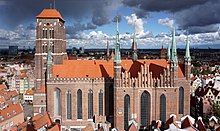

Gdańsk has a number of historical churches, including St. Catherine's Church and St. Mary's Church (Bazylika Mariacka). This latter is a municipal church built during the 15th century, and is the largest brick church in the world.
The city's 17th-century fortifications represent one of Poland's official national Historic Monuments (Pomnik historii), as designated on 16 September 1994 and tracked by the National Heritage Board of Poland.
Other main sights in the historical city centre include:
- Royal Chapel of the Polish King John III Sobieski
- Żuraw – medieval port crane
- Gradowa Hill
- Granaries on the Ołowianka and Granary Islands
- Great Armoury
- John III Sobieski Monument
- Old Town Hall
- Jan Heweliusz Monument
- Great Mill (1350)
- Small Mill
- House of Research Society
- Polish Post Office, site of the 1939 battle
- brick gothic town gates, i.e. Mariacka Gate, Straganiarska Gate, Cow Gate
Main sights outside the historical city centre include:
- Abbot's Palace in the Oliwa Park
- Lighthouse in Nowy Port
- Oliwa Cathedral
- Pachołek Hill – an observation point in Oliwa
- Pier in Brzeźno
- Medieval city walls
- Westerplatte
- Wisłoujście Fortress
- Gdańsk Zoo
Museums[]



- National Museum (Muzeum Narodowe)
- Department of Ancient Art – contains a number of important artworks, including Hans Memling's Last Judgement
- Green Gate
- Department of Modern Art – in the Abbot's Palace in Oliwa
- Ethnography Department – in the Abbot's Granary in Oliwa
- Gdańsk Photography Gallery
- Historical Museum (Muzeum Historyczne Miasta Gdańska):
- Main Town Hall
- Artus' Court
- Uphagen's House
- Amber Museum (Muzeum Bursztynu)
- Museum of the Polish Post (Muzeum Poczty Polskiej)
- Wartownia nr 1 na Westerplatte
- Museum of Tower Clocks (Muzeum Zegarów Wieżowych)
- Wisłoujście Fortress
- National Maritime Museum, Gdańsk (Narodowe Muzeum Morskie):
- Żuraw Crane
- Granaries in Ołowianka
- museum ship SS Soldek is anchored on the Motława River and was the first ship built in post-war Poland.
- European Solidarity Centre. Museum and library dedicated to the history of the Solidarity movement.
- Archeological Museum (Muzeum Archeologiczne)
- Gdańsk Nowy Port Lighthouse (Latarnia Morska Gdańsk Nowy Port)
- Izba Pamięci Wincentego Pola w Gdańsku-Sobieszewie
- Archdiocese Museum (Muzeum Archidiecezjalne)
- Museum of the Second World War
Entertainment[]
- Polish Baltic Philharmonic
- Baltic Opera
- Teatr Wybrzeże
- Gdańsk Shakespeare Theatre is a Shakespearean theatre built on the historical site of a 17th-century playhouse where English travelling players came to perform. The new theatre, completed in 2014, hosts the annual Gdańsk Shakespeare Festival.[107]
Transport[]

- Gdańsk Lech Wałęsa Airport – an international airport located in Gdańsk;
- The Szybka Kolej Miejska, (SKM) the Fast Urban Railway, functions as a Metro system for the Tricity area including Gdańsk, Sopot and Gdynia, operating frequent trains to 27 stations covering the Tricity.[108] The service is operated by electric multiple unit trains at a frequency of 6 minutes to 30 minutes between trains (depending on the time of day) on the central section between Gdańsk and Gdynia, and less frequently on outlying sections. The SKM system has been extended northwest of the Tricity, to Wejherowo, Lębork and Słupsk, 110 kilometres (68 miles) west of Gdynia, and to the south it has been extended to Tczew, 31 kilometres (19 miles) south of Gdańsk.
- Railways: The principal station in Gdańsk is Gdańsk Główny railway station, served by both SKM local trains and PKP long-distance trains. In addition, long-distance trains also stop at Gdańsk Oliwa railway station, Gdańsk Wrzeszcz railway station, Sopot and Gdynia. Gdańsk also has nine other railway stations, served by local SKM trains;
- Long-distance trains are operated by PKP Intercity which provides connections with all major Polish cities, including Warsaw, Kraków, Łódź, Poznań, Katowice and Szczecin, and with the neighbouring Kashubian Lakes region.
In 2011–2015 the Warsaw-Gdańsk-Gdynia railway route underwent a major upgrading costing $3 billion, partly funded by the European Investment Bank, including track replacement, realignment of curves and relocation of sections of track to allow speeds up to 200 km/h (124 mph), modernization of stations, and installation of the most modern ETCS signalling system, which was completed in June 2015. In December 2014 new Alstom Pendolino high-speed trains were put into service between Gdańsk, Warsaw and Kraków reducing the rail travel time from Gdańsk to Warsaw to 2 hours 58 minutes,[109][110] further reduced in December 2015 to 2 hours 39 minutes.[111]
- A new railway, Pomorska Kolej Metropolitalna (PKM, the 'Pomeranian Metropolitan Railway'), commenced service on 1 September 2015, connecting Gdańsk Lech Wałęsa Airport with Wrzeszcz and downtown Gdańsk. It connects to the Szybka Kolej Miejska (Tricity) (SKM) which provides further connections to the entire area served by SKM.
- and trams are operated by ZTM Gdańsk (Zarząd Transportu Miejskiego w Gdańsku).
- From 1 October 2018 selected circuits of line 31 from PKT Gdynia go to bus stop Sopot Ergo Arena without trolley pole. Small part of this rote passes through Gdańsk.
- Port of Gdańsk – a seaport located on the southern coast of Gdańsk Bay within the city;
- Obwodnica Trojmiejska – part of expressway S6 that bypasses the cities of Gdańsk, Sopot and Gdynia.
- The A1 motorway connects the port and city of Gdańsk with the southern border of the country. As of 2014, some fragments of the A1 motorway are still incomplete.
Gdańsk is the starting point of the EuroVelo 9 cycling route which continues southward through Poland, then into the Czech Republic, Austria and Slovenia before ending at the Adriatic Sea in Pula, Croatia.
Additionally, Gdańsk is part of the Rail-2-Sea project. This project's objective is to connect the city with the Romanian Black Sea port of Constanța with a 3,663 kilometres (2,276 miles) long railway line passing through Poland, Slovakia, Hungary and Romania.[112][113]

Gdańsk main railway station (built 1896–1900)

Fast Urban Rail train

Gdańsk tram – Pesa Jazz Duo
Gdańsk bus - Solaris Urbino 12
S6 expressway Tricity
Sports[]
There are many popular professional sports teams in the Gdańsk and Tricity area. Amateur sports are played by thousands of Gdańsk citizens and also in schools of all levels (elementary, secondary, university).
The city's professional football club is Lechia Gdańsk. Founded in 1945, they play in the Ekstraklasa, Poland's top division. Their home stadium, Stadion Miejski, was one of the four Polish stadiums to host the UEFA Euro 2012 competition, as well as the host of the 2021 UEFA Europa League Final. Other notable football clubs are Gedania 1922 Gdańsk and SKS Stoczniowiec Gdańsk, which both played in the second tier in the past.
Other notable clubs include:
- Speedway club Wybrzeże Gdańsk, which competes in the second tier as of 2020, but for decades competed in Poland's top division, most recently in 2014, where it finished 2nd in 1967, 1978 and 1985;
- Rugby club Lechia Gdańsk, which competes in Poland's top division, 13 times Polish champions, most recently in 2014;
- Handball club GKS Wybrzeże Gdańsk, which plays in the Poland's top division, 10 times Polish champions, most recently in 2001, two times European Cup runners up;
- Ice Hockey club Stoczniowiec Gdańsk, which competes in Poland's top division, finishing 3rd in 2003;
- Volleyball club Trefl Gdańsk, which competes in Poland's top division, and finished 2nd in 2015.
The city's Hala Olivia was a venue for the official 2009 EuroBasket,[114] and the Ergo Arena was one of the 2013 Men's European Volleyball Championship, 2014 FIVB Volleyball Men's World Championship and 2016 European Men's Handball Championship venues.
Politics and local government[]
Contemporary Gdańsk is the capital of the province called Pomeranian Voivodeship and is one of the major centres of economic and administrative life in Poland. Many important agencies of the state and local government levels have their main offices here: the Provincial Administration Office, the Provincial Government, the Ministerial Agency of the State Treasury, the Agency for Consumer and Competition Protection, the National Insurance regional office, the Court of Appeals, and the High Administrative Court.
Regional centre[]
Gdańsk Voivodeship was extended in 1999 to include most of former Słupsk Voivodeship, the western part of Elbląg Voivodeship and Chojnice County from Bydgoszcz Voivodeship to form the new Pomeranian Voivodeship. The area of the region was thus extended from 7,394 to 18,293 square kilometres (2,855 to 7,063 sq mi) and the population rose from 1,333,800 (1980) to 2,198,000 (2000). By 1998, Tricity constituted an absolute majority of the population; almost half of the inhabitants of the new region live in the centre.
Municipal government[]
Legislative power in Gdańsk is vested in a unicameral Gdańsk City council (Rada Miasta), which comprises 34 members. Council members are elected directly every four years. Like most legislative bodies, the City Council divides itself into committees which have the oversight of various functions of the city government.
- City Council in 2002–2006
- [115]
- Civic Platform – 15 seats
- Democratic Left Alliance – Labour Union – 6 seats
- Law and Justice – 6 seats
- League of Polish Families – 5 seats
- Self-Defence of the Republic of Poland – 1 seat
- Bogdan Borusewicz – 1 seat
- City Council in 2006–2010
- [116]
- Civic Platform – 21 seats
- Law and Justice – 13 seats
- City Council in 2010–2014
- [117]
- Civic Platform – 26 seats
- Law and Justice – 7 seats
- Democratic Left Alliance – 1 seat

- City Council in 2014–2018
- [118]
- Civic Platform – 22 seats
- Law and Justice – 12 seats
- City Council in 2018–2023
- [119]
- Civic Coalition – 15 seats
- Law and Justice – 12 seats
- – 7 seats
Districts[]
Gdańsk is divided into 34 administrative divisions: 6 dzielnicas and 28 osiedles. Gdańsk dzielnicas include Chełm, Piecki-Migowo, Przymorze Wielkie, Śródmieście, Wrzeszcz Dolny, Wrzeszcz Górny.
Osiedles are Aniołki, Brętowo, Brzeźno, Jasień, Kokoszki, Krakowiec-Górki Zachodnie, Letnica, Matarnia, Młyniska, Nowy Port, Oliwa, Olszynka, Orunia-Św. Wojciech-Lipce, Osowa, Przeróbka, Przymorze Małe, Rudniki, Siedlce, Sobieszewo Island, Stogi, Strzyża, Suchanino, Ujeścisko-Łostowice, VII Dwór, Wzgórze Mickiewicza, Zaspa-Młyniec, Zaspa-Rozstaje, Żabianka-Wejhera-Jelitkowo-Tysiąclecia.
Education and science[]



There are 15 higher schools including three universities. In 2001 there were 60,436 students, including 10,439 graduates.
- University of Gdańsk (Uniwersytet Gdański)
- Gdańsk University of Technology (Politechnika Gdańska)
- Gdańsk Medical University (Gdański Uniwersytet Medyczny)
- Academy of Physical Education and Sport of Gdańsk (Akademia Wychowania Fizycznego i Sportu im. Jędrzeja Śniadeckiego)
- Musical Academy (Akademia Muzyczna im. Stanisława Moniuszki)
- Arts Academy (Akademia Sztuk Pięknych)[120]
- Institute of Fluid Flow Machinery of the Polish Academy of Sciences – Instytut Maszyn Przepływowych im. Roberta Szewalskiego PAN[121]
- Instytut Budownictwa Wodnego PAN
- Ateneum – Szkoła Wyższa
- Gdańska Wyższa Szkoła Humanistyczna
- Gdańska Wyższa Szkoła Administracji
- Wyższa Szkoła Społeczno-Ekonomiczna
- Wyższa Szkoła Turystyki i Hotelarstwa w Gdańsku
- Wyższa Szkoła Zarządzania
- WSB Universities – [122]
Scientific and regional organizations[]
- Gdańsk Scientific Society
- Baltic Institute (Instytut Bałtycki), established 1925 in Toruń, since 1946 (?) in Gdańsk
- TNOiK – Towarzystwo Naukowe Organizacji i Kierowania (Scientific Society for Organization and Management) O/Gdańsk
- IBNGR – Instytut Badań nad Gospodarką Rynkową (The Gdańsk Institute for Market Economics)[123]
International relations[]
Twin towns – sister cities[]
Gdańsk is twinned with:[124]
 Helsingør, Denmark
Helsingør, Denmark Bremen, Germany
Bremen, Germany Cleveland, United States
Cleveland, United States Kaliningrad, Russia
Kaliningrad, Russia Kalmar, Sweden
Kalmar, Sweden Nice, France
Nice, France Nur-Sultan, Kazakhstan
Nur-Sultan, Kazakhstan Rotterdam, Netherlands
Rotterdam, Netherlands Saint Petersburg, Russia
Saint Petersburg, Russia Sefton, England, United Kingdom
Sefton, England, United Kingdom Turku, Finland
Turku, Finland Vilnius, Lithuania
Vilnius, Lithuania
Partnerships and cooperation[]
Gdańsk also cooperates with:[124]
Gallery[]
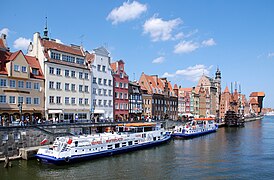
Długie Pobrzeże
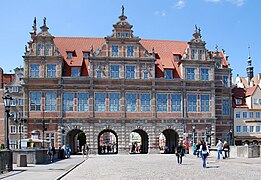
Green Gate
Old Town
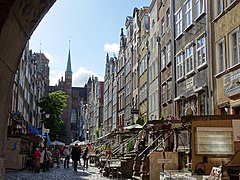
Mariacka Street

Długa Street
Lion's Castle tenement house
Oliwa Cathedral

Old Town Hall

Great Mill (left) and Millers' Guild House (right)

Church of St. John

Rybackie Pobrzeże
Gaol Tower

Monument to the Fallen Shipyard Workers

Millers' Guild House

Saint Barbara church

Swan Tower

Forum Gdańsk shopping centre

Jan Heweliusz Monument
Maersk container ship at DCT Gdańsk

Gdańsk University – Faculty of Law and Administration

Modern blocks in Obrońców Wybrzeża Street

Port of Gdańsk seen from Fryderyk Chopin

Gdańsk Hilton Hotel

European Solidarity Centre
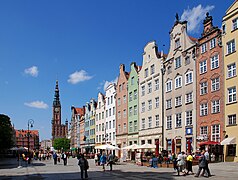
Town hall and Długi Targ
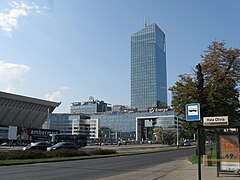
Olivia Business Centre
Population after World War II[]
| Year | Pop. | ±% |
|---|---|---|
| 1890[127] | 120,338 | — |
| 1910[127] | 170,337 | +41.5% |
| 1929[127] | 256,403 | +50.5% |
| 1945[128] | 139,078 | −45.8% |
| 1946 | 117,894 | −15.2% |
| 1950 | 194,633 | +65.1% |
| 1960 | 286,940 | +47.4% |
| 1970 | 365,600 | +27.4% |
| 1980 | 456,707 | +24.9% |
| 1987 | 469,053 | +2.7% |
| 1990 | 465,143 | −0.8% |
| 1995 | 463,019 | −0.5% |
| 2000 | 462,995 | −0.0% |
| 2005 | 458,093 | −1.1% |
| 2010 | 460,509 | +0.5% |
| 2012 | 460,427 | −0.0% |
| 2014 | 461,489 | +0.2% |
| 2019 | 468,158 | +1.4% |
The 1923 Free City of Danzig census shows 95% Germans, and 3% Poles and Kashubians. Subsequent inter-war statistics are subject of dispute[further explanation needed]. The end of World War II is a significant break in continuity with regard to the inhabitants of Gdańsk.
German citizens began to flee en masse as the Soviet Red Army advanced, composed of both spontaneous flights driven by rumors of Soviet atrocities, and organised evacuation starting in the summer of 1944 which continued into the spring of 1945.[129] Approximately 1% (100,000) of the German civilian population residing east of the Oder–Neisse line perished in the fighting prior to the surrender in May 1945.[130] German civilians were also sent as "reparations labour" to the Soviet Union.[131][132] In mid-1945, 4.5 to 4.6 million ethnic Germans remained on the territories that were placed under Polish jurisdiction in accordance with the Potsdam Agreement.[133]
Poles from other parts of Poland replaced the former German population, with the first settlers arriving in March 1945.[134] On 30 March 1945, the Gdańsk Voivodeship was established as the first administrative Polish unit in the Recovered Territories.[135] As of 1 November 1945, around 93,029 Germans remained within the city limits.[128] While the Germans were interned and expelled, close to 5 million settlers[136][137] were either attracted or forced to settle the areas between 1945 and 1950. The locals of German descent who declared Polish nationality were permitted to remain, as of 1 January 1949 13,424 persons who had received Polish citizenship in a post-war "ethnic vetting" process lived in Gdańsk.[138]
The settlers can be grouped according to their background:
- Poles that had been freed from forced labor in Nazi Germany[136][139]
- Repatriates: Poles expelled from the areas east of the new Polish-Soviet border. This included assimilated minorities such as the Polish-Armenian community[136][139]
- Cassubians relocating from nearby villages and small towns
- Settlers from central Poland migrating voluntarily[136]
- non-Poles forcibly resettled during the Operation Vistula in 1947. Large numbers of Ukrainians were forced to move from south-eastern Poland under a 1947 Polish government operation aimed at dispersing, and therefore assimilating, those Ukrainians who had not been expelled eastward already, throughout the newly acquired territories. Belarusians living around the area around Białystok were also pressured into relocating to the formerly German areas for the same reasons. This scattering of members of non-Polish ethnic groups throughout the country was an attempt by the Polish authorities to dissolve the unique ethnic identity of groups like the Ukrainians, Belarusians and Lemkos,[140] and broke the proximity and communication necessary for strong communities to form.
- Jewish Holocaust survivors, most of them Polish repatriates from the Eastern Borderlands.[141]
- Greeks and Macedonians, refugees of the Greek Civil War.
Notable people[]
See also[]
- Tourism in Poland
- List of honorary citizens of Gdańsk
- 764 Gedania – a minor planet orbiting the Sun
- Danzig Highflyer
- Father Eugeniusz Dutkiewicz SAC Hospice
- Kashubians
- Kursenieki
- List of neighbourhoods of Gdańsk
- St. Mary's Church, Gdańsk
- Laznia Centre for Contemporary Art
- Ronald Reagan Park
- Live in Gdańsk
Notes[]
- ^ Record temperatures are from all Gdańsk stations.
References[]
Citations[]
- ^ Jump up to: a b "Local Data Bank". Statistics Poland. Retrieved 21 June 2020. Data for territorial unit 2261000.
- ^ "the definition of gdansk". Dictionary.com.
- ^ "Poland – largest cities (per geographical entity)". World Gazetteer. Retrieved 5 May 2009.[dead link]
- ^ https://gdansk.stat.gov.pl/vademecum/vademecum_pomorskie/portret_obszaru_metropolitalnego/obszar_metropolitalny_gda%C5%84sk-gdynia-sopot.pdf
- ^ "Saint Dominic's Fair is 760 years old!". Retrieved 5 August 2020.
- ^ "Millions at Gdansk's St. Dominic's Fair". www.pap.pl. Article copied to polska.pl. 21 August 2016. Retrieved 30 December 2016.CS1 maint: others (link)
- ^ "Quality of Life Index by City 2019 Mid-Year". www.numbeo.com.
- ^ "Wyborcza.pl". trojmiasto.wyborcza.pl.
- ^ "Gdańsk high in Quality of Life Index". en.ug.edu.pl.
- ^ "Gdansk Guide". archive.is. 3 July 2012. Archived from the original on 3 July 2012. Retrieved 16 April 2019.
- ^ Jump up to: a b Tighe, Carl (1990). Gdańsk: national identity in the Polish-German borderlands. Pluto Press. ISBN 9780745303468. Retrieved 11 February 2016.
- ^ Gumowski, Marian (1966). Handbuch der polnischen Siegelkunde (in German). Retrieved 11 February 2016.
- ^ Also in 1454, 1468, 1484, and 1590
- ^ Also in 1399, 1410, and 1414–1438
- ^ Also in 1410, 1414
- ^ Gdańsk, in: Kazimierz Rymut, Nazwy Miast Polski, Ossolineum, Wrocław 1987
- ^ Hubert Gurnowicz, Gdańsk, in: Nazwy must Pomorza Gdańskiego, Ossolineum, Wrocław 1978
- ^ Baedeker's Northern Germany, Karl Baedeker Publishing, Leipzig 1904
- ^ "The Crane: past and present – Crane – National Maritime Museum in Gdańsk". en.nmm.pl. Retrieved 16 April 2019.
- ^ Jump up to: a b Loew, Peter Oliver: Danzig. Biographie einer Stadt, Munich 2011, p. 24.
- ^ Jump up to: a b Wazny, Tomasz; Paner, Henryk; Golebiewski, Andrzej; Koscinski, Bogdan: Early medieval Gdańsk/Danzig revisited (EuroDendro 2004), Rendsburg 2004, pdf-abstract Archived 9 September 2013 at the Wayback Machine.
- ^ Loew (2011), p. 24; Wazny et al. (2004), abstract Archived 9 September 2013 at the Wayback Machine.
- ^ Hess, Corina (2007). Danziger Wohnkultur in der frühen Neuzeit. Berlin-Hamburg-Münster: LIT Verlag. p. 39. ISBN 978-3-8258-8711-7.
- ^ admin2. "1000 LAT GDAŃSKA W ŚWIETLE WYKOPALISK". Retrieved 18 March 2017.
- ^ Jump up to: a b Hess, Corina (2007). Danziger Wohnkultur in der frühen Neuzeit. Berlin-Hamburg-Münster: LIT Verlag. p. 40. ISBN 978-3-8258-8711-7.
- ^ Jump up to: a b Harlander, Christa (2004). Stadtanlage und Befestigung von Danzig (zur Zeit des Deutschen Ordens). GRIN Verlag. p. 2. ISBN 978-3-638-75010-3.
- ^ Zbierski, Andrzej (1978). Struktura zawodowa, spoleczna i etnicza ludnosci. In Historia Gdanska, Vol. 1. Wydawnictwo Morskie. pp. 228–9. ISBN 978-83-86557-00-4.
- ^ Turnock, David (1988). The Making of Eastern Europe: From the Earliest Times to 1815. Routledge. p. 180. ISBN 978-0-415-01267-6.
- ^ Lingenberg, Heinz (1982). Die Anfänge des Klosters Oliva und die Entstehung der deutschen Stadt Danzig: die frühe Geschichte der beiden Gemeinwesen bis 1308/10. Klett-Cotta. p. 292. ISBN 978-3-129-14900-3.
- ^ ‘The Slippery Memory of Men’: The Place of Pomerania in the Medieval Kingdom of Poland by Paul Milliman p. 73, 2013
- ^ Jump up to: a b Hess, Corina (2007). Danziger Wohnkultur in der frühen Neuzeit. Berlin-Hamburg-Münster: LIT Verlag. pp. 40–41. ISBN 978-3-8258-8711-7.
- ^ Jump up to: a b c d Hess, Corina (2007). Danziger Wohnkultur in der frühen Neuzeit. Berlin-Hamburg-Münster: LIT Verlag. p. 41. ISBN 978-3-8258-8711-7.
- ^ Jump up to: a b c Hartmut Boockmann, Ostpreussen und Westpreussen, Siedler, 2002, p. 158, ISBN 3-88680-212-4
- ^ Jump up to: a b James Minahan, One Europe, Many Nations: A Historical Dictionary of European National Groups, Greenwood Publishing Group, 2000, ISBN 0-313-30984-1, p. 376 Google Books
- ^ Thomas Urban: "Rezydencja książąt Pomorskich". (in Polish) Archived 25 August 2005 at the Wayback Machine
- ^ Hess, Corina (2007). Danziger Wohnkultur in der frühen Neuzeit. Berlin-Hamburg-Münster: LIT Verlag. pp. 41–42. ISBN 978-3-8258-8711-7.
- ^ Frankot, Edda (2012). 'Of Laws of Ships and Shipmen': Medieval Maritime Law and its Practice in Urban Northern Europe. Edinburgh: Edinburgh University Press. p. 100. ISBN 978-0-7486-4624-1.
- ^ Jump up to: a b Hess, Corina (2007). Danziger Wohnkultur in der frühen Neuzeit. Berlin-Hamburg-Münster: LIT Verlag. p. 42. ISBN 978-3-8258-8711-7.
- ^ Loew, Peter O. (2011). Danzig: Biographie einer Stadt. München: C.H.Beck. p. 43. ISBN 978-3-406-60587-1.
- ^ Sobecki, Sebastian (2016). Danzig. Europe: A Literary History, 1348–1418, ed. David Wallace. Oxford University Press. pp. 635–41. ISBN 9780198735359.
- ^ "II Pokój Toruński i przyłączenie Gdańska do Rzeczpospolitej". mgdansk.pl.
- ^ Karol Górski, Związek Pruski i poddanie się Prus Polsce: zbiór tekstów źródłowych, Instytut Zachodni, Poznań, 1949, pp. 16, 18 (in Polish)
- ^ Górski, pp. 51, 56
- ^ Górski, p. 63
- ^ Górski, pp. 71-72
- ^ Górski, pp. 79-80
- ^ "Danzig – Gdańsk until 1920".[permanent dead link]
- ^ Jump up to: a b c Hess, Corina (2007). Danziger Wohnkultur in der frühen Neuzeit. Berlin-Hamburg-Münster: LIT Verlag. p. 45. ISBN 978-3-8258-8711-7.
- ^ Hess, Corina (2007). Danziger Wohnkultur in der frühen Neuzeit. Berlin-Hamburg-Münster: LIT Verlag. p. 45. ISBN 978-3-8258-8711-7.: "Geben wir und verlehen unnsir Stadt Danczk das sie zcu ewigen geczeiten nymands for eynem herrn halden noc gehorsam zcu weszen seyn sullen in weltlichen sachen."
- ^ Juliette Roding, Lex Heerma van Voss (1996). The North Sea and culture (1550–1800): proceedings of the international conference held at Leiden 21–22 April 1995. Uitgeverij Verloren. p. 103. ISBN 978-90-6550-527-9.CS1 maint: uses authors parameter (link)
- ^ "Zielona Brama w Gdańsku". wilanowmiasta.gazeta.pl (in Polish). 18 February 2007. Archived from the original on 29 December 2007. Retrieved 29 December 2008.
- ^ Zamoyski, Adam (2015). Poland. A History. William Collins. pp. 26, 92. ISBN 978-0007556212.
- ^ Bömelburg, Hans-Jürgen, Zwischen polnischer Ständegesellschaft und preußischem Obrigkeitsstaat: vom Königlichen Preußen zu Westpreußen (1756–1806), München: Oldenbourg, 1995, (Schriften des Bundesinstituts für Ostdeutsche Kultur und Geschichte (Oldenburg); 5), zugl.: Mainz, Johannes Gutenberg-Univ., Diss., 1993, p. 549
- ^ Historia Polski 1795–1815 Andrzej Chwalba Kraków 2000, p. 441
- ^ Jump up to: a b Planet, Lonely. "History of Gdańsk – Lonely Planet Travel Information". lonelyplanet.com.
- ^ Górski, p. XVI
- ^ Andrzej Januszajtis, Karol Fryderyk von Conradi, "Nasz Gdańsk", 11 (196)/2017, p. 3 (in Polish)
- ^ "Jan Uphagen". Gdańskie Autobusy i Tramwaje (in Polish). Retrieved 1 April 2020.
- ^ Dzieje Gdańska Edmund Cieślak, Czesław Biernat Wydawn. Morskie, 1969 p. 370
- ^ Dzieje Polski w datach Jerzy Borowiec, Halina Niemiec p. 161
- ^ Polska, losy państwa i narodu Henryk Samsonowicz 1992 Iskry p. 282
- ^ Ergebnisse der Volks- und Berufszählung vom 1. November 1923 in der Freien Stadt Danzig (in German). Verlag des Statistischen Landesamtes der Freien Stadt Danzig. 1926.. Polish estimates of the Polish minority during the interwar era, however, range from 37,000 to 100,000 (9%–34%). Studia historica Slavo-Germanica, Tomy 18–20page 220 Uniwersytet Adama Mickiewicza w Poznaniu. Instytut Historii Wydawnictwo Naukowe imienia. Adama Mickiewicza, 1994.
- ^ Jump up to: a b Maria Wardzyńska, Był rok 1939. Operacja niemieckiej policji bezpieczeństwa w Polsce. Intelligenzaktion, IPN, Warszawa, 2009, pp. 36-37 (in Polish)
- ^ Wardzyńska, p. 37
- ^ Jump up to: a b c Wardzyńska, p. 40
- ^ Jump up to: a b c Wardzyńska, p. 41
- ^ Jump up to: a b Wardzyńska, p. 42
- ^ Wardzyńska, pp. 39-40, 85
- ^ The history of the German resistance, 1933–1945 Peter Hoffmann p. 37 McGill-Queen's University Press 1996
- ^ Hitler Joachim C. Fest p. 586 Houghton Mifflin Harcourt, 2002
- ^ Blitzkrieg w Polsce wrzesien 1939 Richard Hargreaves p. 84 Bellona, 2009
- ^ A military history of Germany, from the eighteenth century to the present dayMartin Kitchen p. 305 Weidenfeld and Nicolson, 1975
- ^ International history of the twentieth century and beyond Antony Best p. 181 Routledge; 2 edition (30 July 2008)
- ^ Jump up to: a b "Gdansk". Retrieved 18 March 2017.
- ^ Bauer, Yehuda (1981). American Jewry and the Holocaust. Wayne State University Press. p. 145. ISBN 978-0-8143-1672-6. Retrieved 11 February 2016.
- ^ "Die "Lösung der Judenfrage" in der Freien Stadt Danzig". www.shoa.de (in German). 30 November 2018. Archived from the original on 29 June 2011.
- ^ "Gdansk, Poland". jewishgen.org.
- ^ Żydzi na terenie Wolnego Miasta Gdańska w latach 1920–1945:działalność kulturalna, polityczna i socjalnaGrzegorz Berendt Gdańskie Tow. Nauk., Wydz. I Nauk Społecznych i Humanistycznych, 1997 p. 245
- ^ Museums Stutthof in Sztutowo. Retrieved 31 January 2007. Archived 24 August 2005 at the Wayback Machine
- ^ "Gdańsk.pl". 3 March 2006. Archived from the original on 3 March 2006.CS1 maint: bot: original URL status unknown (link)
- ^ Grzegorz Baziur, OBEP IPN Kraków (2002). "Armia Czerwona na Pomorzu Gdańskim 1945–1947 (Red Army in Gdańsk Pomerania 1945–1947)". Biuletyn Instytutu Pamięci Narodowej (Institute of National Remembrance Bulletin). 7: 35–38.
- ^ Biskupski, Mieczysław B. The History of Poland. Westport, CT: Greenwood Press, p. 97.
- ^ Tighe, Carl. Gdańsk: National Identity in the Polish-German Borderlands. London: Palgrave Macmillan, p. 199.
- ^ Loew, Peter Oliver (2011). Danzig – Biographie einer Stadt (in German). C.H. Beck. p. 232. ISBN 978-3-406-60587-1. Retrieved 11 February 2016.
- ^ Lech Krzyżanowski; Michał Wożniak; Marek Źak; Wacław Górski (1995). Beautiful historic Gdańsk. Excalibur. p. 769. ISBN 9788390343150.
- ^ Kozinska, Bogdana; Bingen, Dieter (2005). Die Schleifung – Zerstörung und Wiederaufbau historischer Bauten in Deutschland und Polen (in German). Deutsches Polen-Institut. p. 67. ISBN 978-3-447-05096-8. Retrieved 11 February 2016.
- ^ Loew, Peter Oliver (2011). Danzig – Biographie einer Stadt (in German). C.H. Beck. p. 146. ISBN 978-3-406-60587-1.
- ^ Kalinowski, Konstanty; Bingen, Dieter (2005). Die Schleifung – Zerstörung und Wiederaufbau historischer Bauten in Deutschland und Polen (in German). Deutsches Polen-Institut. p. 89. ISBN 978-3-447-05096-8. Retrieved 11 February 2016.
- ^ Friedrich, Jacek (2010). Neue Stadt in altem Glanz – Der Wiederaufbau Danzigs 1945–1960 (in German). Böhlau. pp. 30, 40. ISBN 978-3-412-20312-2.
- ^ Czepczynski, Mariusz (2008). Cultural landscapes of post-socialist cities: representation of powers and needs. Ashgate publ. p. 82. ISBN 978-0-7546-7022-3.
- ^ Friedrich, Jacek (2010). Neue Stadt in altem Glanz – Der Wiederaufbau Danzigs 1945–1960 (in German). Böhlau. pp. 34, 102. ISBN 978-3-412-20312-2.
- ^ "W Gdańsku otwarto Europejskie Centrum Solidarności" (in Polish). Onet.pl. 31 August 2014. Retrieved 7 August 2015.[dead link]
- ^ "Italy's Mogherini and Poland's Tusk get top EU jobs". BBC. 30 August 2014. Retrieved 8 August 2015.
- ^ "Gdansk mayor Pawel Adamowicz dies after being stabbed in heart on stage". CNN. 14 January 2019. Retrieved 14 January 2019.
- ^ "Mayor of Polish city dies after stabbing at charity event". www.msn.com. Archived from the original on 15 January 2019. Retrieved 16 April 2019.
- ^ "Polish city of Gdansk wins Princess of Asturias Award". Retrieved 19 October 2019.
- ^ "Gdansk". Weatherbase.com. Retrieved 14 February 2018.
- ^ "Köppen climate classification". Britannica. Retrieved 14 February 2018
- ^ "World Weather Information Service – Gdańsk". WMO. Retrieved 20 October 2015.
- ^ "Gdańsk Średnie i sumy miesięczne". meteomodel.pl. Retrieved 14 January 2020.
- ^ Jump up to: a b c d e f g h "Gdańsk - miasto które przyciąga". Retrieved 30 July 2020.
- ^ https://archive.today/20130124034524/http://www.fineos.com/about/locations/ FINEOS Locations
- ^ Russell Sturgis; Arthur Lincoln Frothingham (1915). A history of architecture. Baker & Taylor. p. 293.
- ^ Paul Wagret; Helga S. B. Harrison (1964). Poland. Nagel. p. 302.
- ^ "The New Jury House (The Gdańsk Hall)". Pomorskie.travel. Retrieved 1 May 2020.
- ^ ROBiDZ w Gdańsku. "Kaplica Królewska w Gdańsku". www.wrotapomorza.pl (in Polish). Archived from the original on 10 February 2015. Retrieved 29 December 2008.
- ^ Snow, Georgia (3 September 2014). "Elizabethan playhouse in Poland to host work by Shakespeare's Globe". The Stage. Retrieved 15 September 2014.
- ^ SKM Passenger Information, Map http://www.skm.pkp.pl/
- ^ Polish Pendolino launches 200 km/h operation, Railway Gazette International, 15 December 2014
- ^ "Pendolino z Trójmiasta do Warszawy. Więcej pytań niż odpowiedzi". trojmiasto.pl. 30 July 2013.
- ^ ';Jeszcze szybciej z Warszawy do Gdańska,' Kurier Kolejowy 9 January 2015 http://www.kurierkolejowy.eu/aktualnosci/22716/Jeszcze-szybciej-z-Warszawy-do-Gdanska.html Archived 10 January 2015 at the Wayback Machine
- ^ Mutler, Alison (12 October 2020). "Rail-2-Sea and Via Carpathia, the US-backed highway and rail links from the Baltic to the Black Sea". Universul.net.
- ^ Lewkowicz, Łukasz (2020). "The Three Seas Initiative as a new model of regional cooperation in Central Europe: A Polish perspective". UNISCI Journal. 18 (54): 177–194. doi:10.31439/UNISCI-101.
- ^ 2009 EuroBasket, ARCHIVE.FIBA.com, Retrieved 5 June 2016.
- ^ "Państwowa Komisja Wyborcza: Wybory samorządowe". wybory2002.pkw.gov.pl. Retrieved 9 October 2015.
- ^ "Geografia wyborcza – Wybory samorządowe – Państwowa Komisja Wyborcza". wybory2006.pkw.gov.pl. Retrieved 9 October 2015.
- ^ "Wybory Samorządowe 2010 – Geografia wyborcza – Województwo pomorskie – – m. Gdańsk". wybory2010.pkw.gov.pl. Retrieved 9 October 2015.
- ^ "Państwowa Komisja Wyborcza | Gdańsk". wybory2014.pkw.gov.pl. Archived from the original on 18 December 2014. Retrieved 9 October 2015.
- ^ "Państwowa Komisja Wyborcza | Gdańsk". wybory2018.pkw.gov.pl.
- ^ "Akademia Sztuk Pięknych w Gdańsku". asp.gda.pl.
- ^ "Institute of Fluid Flow Machinery of the Polish Academy of Sciences". imp.gda.pl/en.
- ^ WSB University in Gdańsk Archived 14 February 2016 at the Wayback Machine – WSB Universities
- ^ "The Gdańsk Institute for Market Economics". Archived from the original on 9 February 2008. Retrieved 25 July 2009.
- ^ Jump up to: a b "Partner Cities". gdansk.pl. Gdańsk. Retrieved 2 August 2020.
- ^ "Miasta współpracujące". Retrieved 17 August 2020.
- ^ "Le Havre – Les villes jumelées" [Le Havre – Twin towns]. City of Le Havre (in French). Archived from the original on 29 July 2013. Retrieved 7 August 2013.
- ^ Jump up to: a b c Michael Rademacher. "Verwaltungsgeschichte.de" (in German).
- ^ Jump up to: a b Sylwia Bykowska (2020). The Rehabilitation and Ethnic Vetting of the Polish Population in the Voivodship of Gdańsk after World War II. Peter-Lang-Verlagsgruppe. p. 116. ISBN 978-3-631-67940-1.
- ^ Arie Marcelo Kacowicz, Pawel Lutomski, Population resettlement in international conflicts: a comparative study, Lexington Books, 2007, pp. 100, 101 ISBN 0-7391-1607-X [1]
- ^ Spieler, Silke. ed. Vertreibung und Vertreibungsverbrechen 1945–1948. Bericht des Bundesarchivs vom 28. Mai 1974. Archivalien und ausgewählte Erlebnisberichte. Bonn: Kulturstiftung der deutschen Vertriebenen. (1989). ISBN 3-88557-067-X. pp. 23–41
- ^ Pavel Polian-Against Their Will: The History and Geography of Forced Migrations in the USSR Central European University Press 2003 ISBN 963-9241-68-7 pp. 286-293
- ^ Kamusella 2004, p. 28.
- ^ Ludność Polski w XX wieku Andrzej Gawryszewski. Warszawa : Instytut Geografii i Przestrzennego Zagospodarowania im. Stanisława Leszczyckiego PAN, 2005. pp. 455-460, 466
- ^ Curp, T. David (2006). A clean sweep?: the politics of ethnic cleansing in western Poland, 1945-1960. Boydell & Brewer. p. 42. ISBN 1-58046-238-3. Retrieved 4 August 2009.
- ^ Roos, Hans (1966). A history of modern Poland: from the foundation of the State in the First World War to the present day. Knopf. Retrieved 4 August 2009.
- ^ Jump up to: a b c d Karl Cordell, Andrzej Antoszewski, Poland and the European Union, 2000, p. 168, ISBN 0-415-23885-4, ISBN 978-0-415-23885-4: gives 4.55 million in the first years
- ^ Piotr Eberhardt, Jan Owsinski, Ethnic Groups and Population Changes in Twentieth-century Central-Eastern Europe: History, Data, Analysis, 2003, p. 142 gives 4,79 million as of 1950, ISBN 0-7656-0665-8, ISBN 978-0-7656-0665-5
- ^ Bykowska, Sylwia (2020). The Rehabilitation and Ethnic Vetting of the Polish Population in the Voivodship of Gdańsk after World War II. Peter Lang. p. 239. ISBN 978-3-631-67940-1.
- ^ Jump up to: a b Hoffmann, Dierk; Schwartz, Michael (1999). Dierk Hoffmann, Michael Schwartz, Geglückte Integration?, p. 142. ISBN 9783486645033.
- ^ Thum, p. 129
- ^ Selwyn Ilan Troen, Benjamin Pinkus, Merkaz le-moreshet Ben-Guryon, Organizing Rescue: National Jewish Solidarity in the Modern Period, pp. 283-284, 1992, ISBN 0-7146-3413-1, ISBN 978-0-7146-3413-5
Bibliography[]
- Kimmich, Christoph M (1968). The free city: Danzig and German foreign policy, 1919–1934. Yale University Press, New Haven, Connecticut. Retrieved 8 March 2010.
- Rudziński, Grzegorz (1 March 2001). Gdańsk. Bonechi. ISBN 978-88-476-0517-6. Retrieved 26 February 2010.
- Simson, Paul (October 2009). Geschichte Der Stadt Danzig. BiblioBazaar, LLC. ISBN 978-1-115-53256-3. Retrieved 26 February 2010.
External links[]
| Wikimedia Commons has media related to Gdańsk. |
| Wikisource has the text of the 1911 Encyclopædia Britannica article Danzig . |
| Wikivoyage has a travel guide for Gdańsk. |
| Look up Gdańsk in Wiktionary, the free dictionary. |
- Official website

- The official tourist service of the Marshal's Office of the Pomeranian Voivodeship
- Virtual Gdańsk (in Polish)
- Danzig (in German)
- Gdańsk (in German)
- European Jamboree 2020 Archived 20 March 2019 at the Wayback Machine
- The power of Gdansk article at The Globe and Mail
- 7 Reasons to Fall in Love with Gdańsk
- Gdańsk
- 980s establishments
- Populated places established in the 10th century
- Members of the Hanseatic League
- City counties of Poland
- Cities and towns in Pomeranian Voivodeship
- Port cities and towns of the Baltic Sea
- Geographical naming disputes
- Holocaust locations in Poland
- Nazi war crimes in Poland
